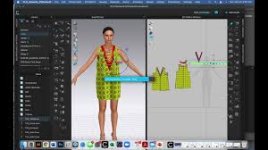Introduction: From Sketchpad to Screen
Fashion design has always been a blend of creativity and craftsmanship. But today, with the rise of 3D computer graphics, designers are taking their creative processes from the sketchpad to the screen—transforming how garments are conceptualized, visualized, and brought to life.
Rather than waiting weeks to see how a prototype will look in real life, designers can now simulate everything—from fabric drape to lighting effects—through 3D modeling. This not only saves time and cost but also opens the door to global collaboration and experimentation.
What is 3D Fashion Prototyping?
3D prototyping in fashion refers to the use of computer-generated models to create digital clothing samples before producing physical versions. These simulations allow designers to:
- Adjust colors, cuts, and textures
- Evaluate fit on digital mannequins
- Simulate garment movement
- Share prototypes with teams or clients instantly
This process has become a game-changer in both high fashion and mass production sectors
Key Advantages of 3D Graphics in Fashion Prototyping
1. Faster Design Cycle
Traditional prototyping takes days or weeks. With 3D tools, a full outfit can be simulated in hours.
2. Cost Savings
No more need for multiple rounds of physical samples. Designers can test and modify digitally until ready.
3. Eco-Friendly Process
Reducing fabric waste and unnecessary samples makes the fashion cycle more sustainable.
4. Better Communication
Designers, tailors, and buyers can all view a common digital model, reducing misunderstandings.
5. Global Collaboration
Fashion teams across countries can work in real-time on the same designs without shipping delays
Real-World Use Cases
- Zara & H&M use 3D graphics to quickly test new styles in fast fashion cycles.
- Nike creates virtual prototypes of athletic wear to test fit and function before production.
- Luxury brands like Balenciaga have showcased digital-only clothing lines for fashion shows and NFTs.
Challenges in Adopting 3D Graphics
- Learning Curve: Traditional designers must adapt to digital tools
- Hardware Demand: Rendering realistic garments needs high-performance systems
- Fabric Feel: Simulating physical fabric’s texture and behavior still has limits
- Customization Complexity: Incorporating user sizes and preferences for mass customization can be intricate
The Future of Digital Fashion
The fashion world is already seeing the rise of digital fashion shows, virtual dressing rooms, and metaverse-based fashion commerce. 3D graphics are leading this revolution.
Soon, customers may browse entire fashion collections virtually, try on outfits through AR, and purchase made-to-measure clothes—all powered by advanced computer graphics.
Join the Conversation
Have you ever tried a virtual dressing room on a shopping app?
Do you think digital prototyping can replace traditional tailoring in the near future?
Should fashion education include 3D graphics as a core subject?
Let us know your thoughts in the comments!

